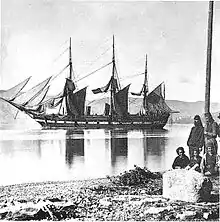| Archduke Friedrich | |||||
|---|---|---|---|---|---|
 Archduke Friedrich of Austria, lithography by Johann Stadler, 1841 | |||||
| Born | 14 May 1821 Vienna, Austrian Empire | ||||
| Died | 5 October 1847 (aged 26) Venice, Kingdom of Lombardy–Venetia, Austrian Empire | ||||
| |||||
| House | Habsburg-Lorraine | ||||
| Father | Archduke Charles, Duke of Teschen | ||||
| Mother | Princess Henrietta of Nassau-Weilburg | ||||
Archduke Friedrich Ferdinand Leopold of Austria (German: Erzherzog Friedrich Ferdinand Leopold von Österreich) (14 May 1821 – 5 October 1847) was a member of the House of Habsburg and Commander-in-Chief of the Austrian Navy.
Family
Friedrich was the third son of Field Marshal Archduke Charles of Austria (1771–1847) and Princess Henrietta of Nassau-Weilburg (1797–1829). He never married and did not leave issue.
Military career in the Navy
Born in Vienna, Friedrich joined the Imperial Austrian Navy in 1837 at the age of sixteen. He threw himself into this career with much zeal and quickly rose to command a ship, sailing to the Orient for the first time in 1839.
Oriental Crisis of 1840
During the Oriental Crisis of 1840 between Egypt and the Ottoman Empire, Friedrich fought in the campaign against Muhammad Ali after the Convention of London. He served with the Austrian fleet off the Levantine coast as commander of the ship Guerriera.
In that convention, the United Kingdom, Austria, Prussia, and Russia had offered Muhammad Ali hereditary rule of Egypt as part of the Ottoman Empire if he withdrew from the Syrian hinterland and the coast of Mount Lebanon. Muhammad Ali hesitated until British naval forces moved against Syria and Alexandria.[1] After the British and Austrian navies blockaded the Nile delta coastline, shelled Beirut (on September 11, 1840), and after Acre had surrendered (on November 3, 1840), Muhammad Ali agreed to the terms of the Convention on November 27, 1840.[2]
From his ship Friedrich directed the assault on the citadels of Sidon and Beirut which soon fell. On September 24, Admiral Stopford decided to occupy Saida and the Austrian ship "Guerriera", on which the Archduke Friedrich was, was added to this expedition. At 11 a.m. on September 26, the firing on Saïda began. Immediately the attack had to be continued on land, the troops disembarked and led to the storm. It was then that the Archduke led the troops ahead of all others against the Bergcastell and by 6 o'clock in the afternoon was master of the square. 1,500 men of the crew were taken prisoner.
With taking Saida, the most important citadel, Acre, had to be taken yet. On 3 November 1840 shelling began without interruption. The magnificent battle scene reached its climax when, at half past four, a powder depot in the fortress blew up and caused tremendous devastation. Following the bombardment of Acre on 3-4 November 1840, he decided to attack the citadel that night and personally led a small landing party of Austrian, British and Ottoman Turkish troops and took the citadel of Acre after the Egyptian garrison had fled. They hoisted the Turkish, British and Austrian flags over the citadel. For his exceptional leadership during the campaign he was appointed Knight of the Military Order of Maria Theresa. He also received military awards from numerous other countries.
Commander-in-Chief

In 1842 Friedrich sailed to Algeria and England. In 1844 he was promoted to the rank of vice admiral and took office as Commander-in-Chief of the Imperial Austrian Navy at the age of twenty-three. His appointment came after a mutiny by Venetian junior officers led by the sons of Admiral Baron Francesco Bandiera.
As Commander-in-Chief, Friedrich introduced many modernising reforms, aiming to make his country's naval force less "Venetian" and more "Austrian". In Austria there had until the end of the eighteenth century only been limited attempts at establishing a navy of its own. When the Habsburgs received the city of Venice along with Istria and Dalmatia following the Treaty of Campo Formio in 1797, this situation was changed considerably. The Venetian naval forces and facilities were handed over to Austria and became the basis of the formation of the future Austrian Navy. Until Friedrich's term as Commander-in-Chief it was however often felt that the force officially styled the "Austrian Navy" was in practice little more than Venetian crews and ships sailing under the Austrian flag.
Friedrich had a keen private interest in the fleet, and with him the Austrian naval force gained its first influential supporter from the ranks of the Imperial Family. This was crucial as sea power was never a priority of the Austrian foreign policy and the navy itself was relatively little known or supported by the public. It was only able to draw significant public attention and funds during the three short periods of its history when it was actively supported by an imperial prince. Following Friedrich's example, the archdukes Ferdinand Maximilian (1832–1867) and Franz Ferdinand (1863–1914) would later become active campaigners for naval matters.
The Austrian Chancellor Prince Klemens von Metternich proposed that Friedrich be named Grand Master of the Sovereign Military Order of Malta, but this was rejected by Pope Gregory XVI.[3]
Friedrich's term as Commander-in-Chief of the Imperial Austrian Navy was cut short. He died of jaundice in Venice at the age of twenty-six, only three years after taking office.
The large sailboat SMS Erzherzog Friedrich and the battleship SMS Erzherzog Friedrich (1902) were named after him.
Honours
He received the following awards:[4]
 Austrian Empire:[5]
Austrian Empire:[5]
- Knight of the Golden Fleece, 1838
- Knight of the Military Order of Maria Theresa, 1840
.svg.png.webp) Kingdom of Bavaria: Knight of St. Hubert, 1844[6]
Kingdom of Bavaria: Knight of St. Hubert, 1844[6] Grand Duchy of Hesse: Grand Cross of the Ludwig Order
Grand Duchy of Hesse: Grand Cross of the Ludwig Order.svg.png.webp) Holy See: Grand Cross of St. Gregory the Great, in Diamonds
Holy See: Grand Cross of St. Gregory the Great, in Diamonds.svg.png.webp) Sovereign Military Order of Malta: Professed Knight and Grand Cross of Honour and Devotion, 1845
Sovereign Military Order of Malta: Professed Knight and Grand Cross of Honour and Devotion, 1845 Netherlands: Grand Cross of the Netherlands Lion
Netherlands: Grand Cross of the Netherlands Lion.svg.png.webp) Kingdom of Portugal: Grand Cross of the Tower and Sword
Kingdom of Portugal: Grand Cross of the Tower and Sword.svg.png.webp) Kingdom of Prussia:
Kingdom of Prussia:
- Pour le Mérite (military), 30 November 1840[7]
- Knight of the Black Eagle, 4 September 1844[8]
.svg.png.webp) Two Sicilies: Grand Cross of St. Ferdinand and Merit
Two Sicilies: Grand Cross of St. Ferdinand and Merit United Kingdom: Honorary Grand Cross of the Bath (military), 5 November 1842[9]
United Kingdom: Honorary Grand Cross of the Bath (military), 5 November 1842[9] Russian Empire:
Russian Empire:
Ancestry
| Ancestors of Archduke Friedrich of Austria (1821–1847) | |||||||||||||||||||||||||||||||||||||||||||||||||||||||||||||||||||||||||||||||||||||||||||||||||||||||||||||||||||||||||||||||||||||||||||||||||||||||||||||||||||||||||||||||||||||||||||||||||||||||||||||||||||||||||||||||||||||||||||||||||||||||||||||||||||||||||||||||||||||||||
|---|---|---|---|---|---|---|---|---|---|---|---|---|---|---|---|---|---|---|---|---|---|---|---|---|---|---|---|---|---|---|---|---|---|---|---|---|---|---|---|---|---|---|---|---|---|---|---|---|---|---|---|---|---|---|---|---|---|---|---|---|---|---|---|---|---|---|---|---|---|---|---|---|---|---|---|---|---|---|---|---|---|---|---|---|---|---|---|---|---|---|---|---|---|---|---|---|---|---|---|---|---|---|---|---|---|---|---|---|---|---|---|---|---|---|---|---|---|---|---|---|---|---|---|---|---|---|---|---|---|---|---|---|---|---|---|---|---|---|---|---|---|---|---|---|---|---|---|---|---|---|---|---|---|---|---|---|---|---|---|---|---|---|---|---|---|---|---|---|---|---|---|---|---|---|---|---|---|---|---|---|---|---|---|---|---|---|---|---|---|---|---|---|---|---|---|---|---|---|---|---|---|---|---|---|---|---|---|---|---|---|---|---|---|---|---|---|---|---|---|---|---|---|---|---|---|---|---|---|---|---|---|---|---|---|---|---|---|---|---|---|---|---|---|---|---|---|---|---|---|---|---|---|---|---|---|---|---|---|---|---|---|---|---|---|---|---|---|---|---|---|---|---|---|---|---|---|---|---|---|---|---|
| |||||||||||||||||||||||||||||||||||||||||||||||||||||||||||||||||||||||||||||||||||||||||||||||||||||||||||||||||||||||||||||||||||||||||||||||||||||||||||||||||||||||||||||||||||||||||||||||||||||||||||||||||||||||||||||||||||||||||||||||||||||||||||||||||||||||||||||||||||||||||
Notes
- ↑ H. Wood Jarvis, Pharaoh to Farouk, (London: John Murray, 1956), 134.
- ↑ Morroe Berger, Military Elite and Social Change: Egypt Since Napoleon, (Princeton, New Jersey: Center for International Studies, 1960), 11.
- ↑ H.J.A. Sire, The Knights of Malta (New Haven: Yale University Press, 1994), 251.
- ↑ "Genealogisches Verzeichnis des gefammten Hauses Oesterreich", Hof- und Staatshandbuch des österreichischen Kaiserthumes, 1848, p. viii, retrieved 23 July 2020
- ↑ "Ritter-orden", Hof- und Staatshandbuch des österreichischen Kaiserthumes, 1847, p. 8, 14, retrieved 23 July 2020
- ↑ Bayern (1847). Hof- und Staatshandbuch des Königreichs Bayern: 1847. Landesamt. p. 9.
- ↑ Lehmann, Gustaf (1913). Die Ritter des Ordens pour le mérite 1812–1913 [The Knights of the Order of the Pour le Mérite] (in German). Vol. 2. Berlin: Ernst Siegfried Mittler & Sohn. p. 409.
- ↑ Liste der Ritter des Königlich Preußischen Hohen Ordens vom Schwarzen Adler (1851), "Von Seiner Majestät dem Könige Friedrich Wilhelm IV. ernannte Ritter" p. 22
- ↑ Shaw, Wm. A. (1906) The Knights of England, I, London, p. 189
Further reading
Dauber, Robert L. Erzherzog Friedrich von Österreich: Admiral und Ordensritter. Graz: Styria, 1993. ISBN 3-222-12218-0.